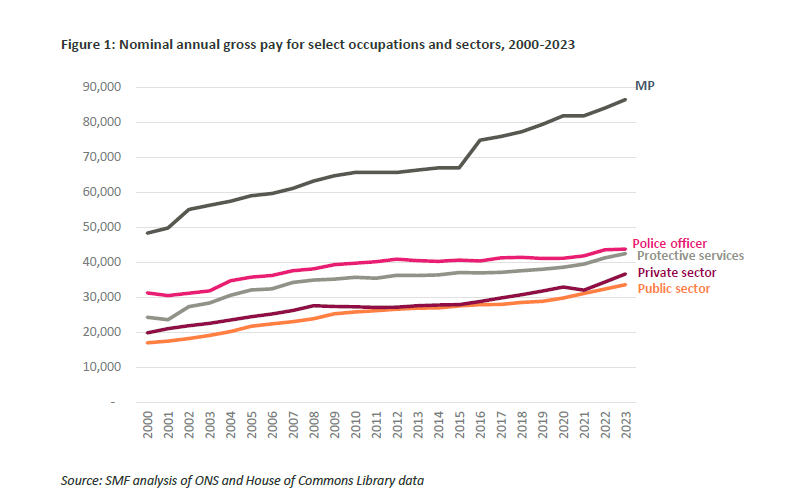In March 2023, the SMF carried out analysis of police pay, revealing a real-terms decline for officers over the past decade, while projecting a continued decrease in spending power in the years ahead.
Using the most recent data, this blog provides an update of that work. While estimates have remained relatively stable, the impact of inflationary pressures suggests that the outlook for police pay is now anticipated to worsen beyond last year’s expectations.
A quick note on data
The analysis of police pay levels is based on data from the Office for National Statistics (ONS). They run an Annual Survey of Hours and Earnings every April, which presents data from across professions.
For policing, they give the results in two groupings: “Police officers (sergeant and below)” and “Senior police officers”, which includes everything from inspector and above. The ONS data does not therefore allow for a division into federated and unfederated police officer ranks. The results in this blog take an average of the “Police officers” and “Senior police officers” categories, weighted based upon the number of officers in each grouping. This average thus includes all ranks
from constable up to chief officer and superintendent.
However, there were only 1,685 superintendents, chief superintendents and chief officers as of March 2023 in the unfederated ranks, compared to c150,000 in federated ranks. The results presented in this report, then, will be overwhelmingly dominated by the federated ranks, which
represent 98-99 per cent of the sample.
The real value of police pay has decreased significantly
Analysis of ONS earnings data shows that police officer pay rose by 40 per cent between 2000 and 2023.i ii iii However, when compared with the pay change of other workers – protective service officers (75 per cent),iv public sector workers (98 per cent), and those employed in the private sector (85 per cent) – this increase becomes less impressive. MPs, as an additional comparator group, have seen their salaries increase by 79 per cent. cite cite cite
In real terms, taking into account inflation of 80 per cent over the past two decades, this equates to an actual decline in police pay of 22 per cent between April 2000 and April 2023. Within the broader protective services occupation category, which refers to police, fire, and prison officers collectively, the overall decrease has been much smaller (-3 per cent), suggesting a substantial erosion of purchasing power for police officers compared with analogous roles.
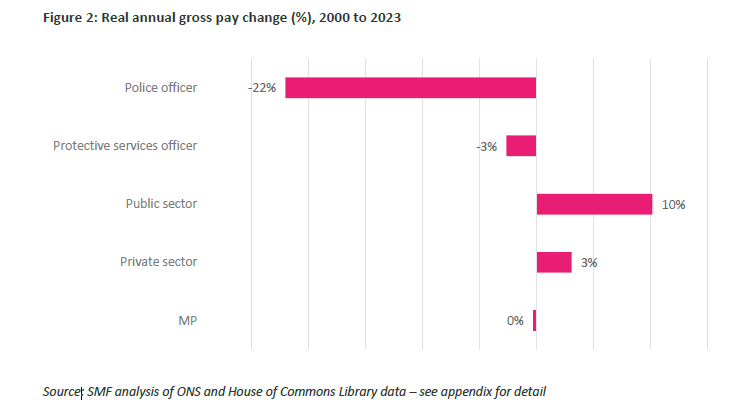
In contrast, the average public sector worker has seen their salary increase in real terms (10 per cent), as has the average private sector worker (3 per cent). MPs salaries have remained unchanged (0 per cent) in real-terms. cite cite cite
While this does not categorise them as a complete outlier, it does highlight that police officers have become significantly worse off compared to their counterparts in other occupations.
The police received a 7 per cent pay rise, coming into effect in September 2023, after the ONS survey was taken cite. This takes the average pay, which includes the federated and unfederated ranks as per the ONS data, from £43,829 in 2023 to £46,897 in 2024. It is possible to use this, as well as inflation forecasts for 2024, to forecast a 19.5 per cent decline in real pay from 2000 to 2024. This means they will have slightly more purchasing power this year than they did in 2023. The 2023-24 pay deal data for the comparison professions is not available, so figures 1 and 2 are based upon the 2000 to 2023 data from the ONS surveys.
We also looked at what would happen if these trends were to continue. With prices expected to increase – the OBR forecasts 11 per cent growth in the Consumer Price index by 2028 cite – unless changes are made to how much officers earn in the coming years, our analysis suggests the real-terms value of police pay will continue to decline.
Rolling forward the 2000 to 2023 pay trends, a further 5 per cent pay reduction for police officers between 2023 and 2028 is implied, compared to a rise in pay for public sector workers (2 per cent) and private sector workers (1 per cent). The pay of MPs (0 per cent) is expected to remain the same, while protective service officer earnings are also set to decline (1 per cent).
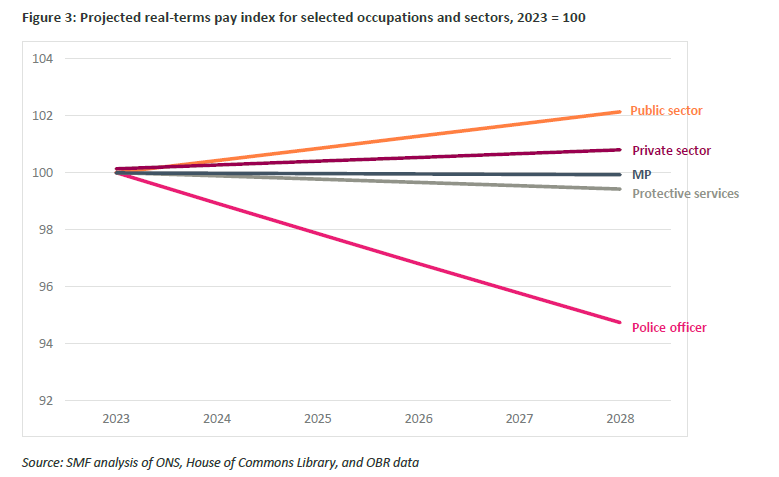
Another way of examining earnings growth is by looking at starting salaries. From 1979, we find that the pay trajectory of new police constables, though not showing a real-terms decline, has risen slower than earnings across the economy (v). The starting salary of new constables, at £3,600 was almost exactly in line with the salary of the average worker in 1979, at £3,608. Constable starting salaries then increased by 71 per cent in real terms across this period, while the pay of all workers has increased by 108 per cent.
As displayed in Figure 4, in 2023 new police constables earned £28,551, a nominal increase of £24,951, while the average worker earned £34,855, a much larger increase of £31,247. cite cite cite cite
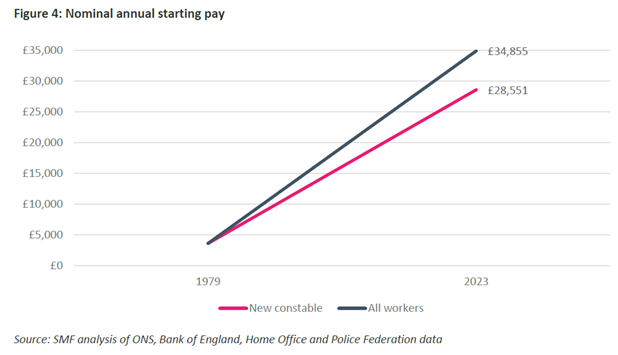
Dissatisfaction with police pay is widespread
The vast majority of police are unhappy with the amount they are paid. The Police Federation of England and Wales (PFEW)’s 2023 Pay and Morale Survey of around 30,000 police officers has found a substantial 79 per cent expressed dissatisfaction with basic pay and 78 per cent with overall remuneration.
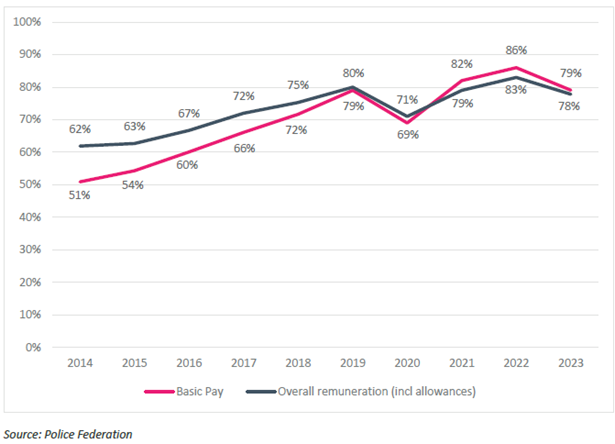
Considering the stresses and strains they experience at work, PFEW data also reveals that the vast majority (92 per cent) of police officers disagree with the notion they are fairly paid. Similarly, 85 per cent disagree that they are fairly paid considering the hazards they face within the job. Illustrating a significant lack of morale in the police force, more than half (52 per cent) state that their current level of pay increases their intention to leave the police service entirely.
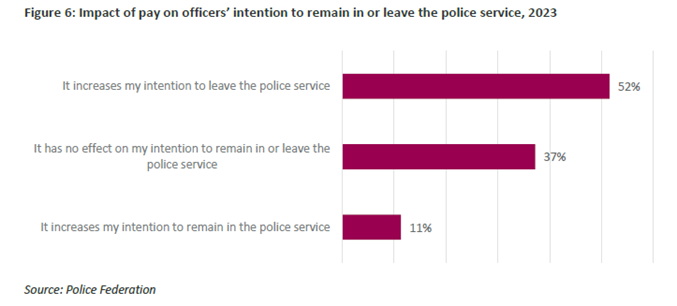
Police pay and the ‘P-Factor’
Another aspect in the discussion around police pay are the inherent dangers officers face while in the line of duty. Because police have unique obligations and responsibilities compared to most other jobs – responding to emergency calls, maintaining public order, and handing potentially dangerous situations – they can often find themselves exposed to an increased level of harm, as well as other restrictions.
Within policing circles, this is commonly referred to as the ‘P-Factor’. It is argued this factor should be duly acknowledged in police pay structures, remunerating officers for the challenges they may encounter as a result of carrying out their duties.
The practical implementation of this concept remains uncertain, however. For example, it could serve as a base pay policy that incorporates compensation directly into officer’s salaries, or the P-Factor could be added on to base pay.
The National Police Chiefs’ Council (NPCC) has proposed that there are 12 elements in total that contribute to the day-to-day risks faced by officers; factors that should be taken into consideration and incorporated into the design of the P-Factor as part of pay reform (see appendix 2). cite This includes risks typically associated with the role, such as physical confrontation or psychological hazards, as well other legal and socioeconomic factors.
For example, the NPCC say that, due to being legally obliged to act to prevent crime even when not working, it could be argued that police officers are never truly ‘off duty’. Nonfeasance can affect officers’ ability to enjoy their private life, as well as risking safety. The Council also emphasises that police are victimised because of their profession, leading to the damage of personal property, bullied children, or threats made while off duty. cite
Further research is required
The value of police pay has eroded in real terms since 2000, and to a greater extent than similar roles in the protective services. Officer dissatisfaction is widespread, with opinions on pay increasing peoples’ intention to leave the service.
There is a strong argument for increasing transparency around the P-Factor. What precisely does it include, how are these valued, and – crucially – how is it accounted for in policy pay. To address these questions, further research is needed to nail down the principles underpinning the P-Factor, developing an appropriate methodology for calculating it, and thus identifying what the appropriate level of remuneration should be across duties and roles.
i ONS pay data for 2023 is currently provisional, and may contain inaccuracies. As a result, figures used in this briefing may undergo revisions over time. Estimates should be approached with a degree of caution.
ii There is a methodological change between 2005 and 2006 in the ONS pay data series. For protective services officer and police officer pay, we have included data on both senior and non-senior staff pay.
iii Police officer pay is unavailable for 2002.
iv Protective services occupations are jobs that exist to maintain order and ensure public safety, including police officers, members of the armed forces, firefighters, prison officers, and paramedics.
v Pending the release of Q4 figures, all workers earnings data for the whole of 2023 is currently unavailable. Q3 data has been used instead.
Further reading materials





